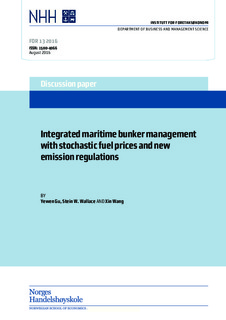Integrated maritime bunker management with stochastic fuel prices and new emission regulations
Working paper

Åpne
Permanent lenke
http://hdl.handle.net/11250/2401600Utgivelsesdato
2016-08-25Metadata
Vis full innførselSamlinger
- Discussion papers (FOR) [566]
Sammendrag
Maritime bunker management (MBM) controls the procurement and consumption of the fuels used on board and therefore manages one of the most important cost drivers in the shipping industry. At the operational level, a shipping company needs to manage its fuel consumption by making optimal routing and speed decisions for each voyage. But since fuel prices are highly volatile, a shipping company sometimes also needs to do tactical fuel hedging in the forward market to control risk and cost volatility. From an operations research perspective, it is customary to think of tactical and operational decisions as tightly linked. However, the existing literature on MBM normally focuses on only one of these two levels, rather than taking an integrated point of view. This is in line with how shipping companies operate; tactical and operational bunker management decisions are made in isolation. We develop a stochastic programming model involving both tactical and operational decisions in MBM in order to minimize the total expected fuel costs, controlled for financial risk, within a planning period. This paper points out that after the latest regulation of the Sulphur Emission Control Areas (SECA) came into force in 2015, an integration of the tactical and operational levels in MBM has become important for shipping companies whose business deals with SECA. The results of the computational study shows isolated decision making on either tactical or operational level in MBM will lead to various problem. Nevertheless, the most server consequence occurs when tactical decisions are made in isolation.